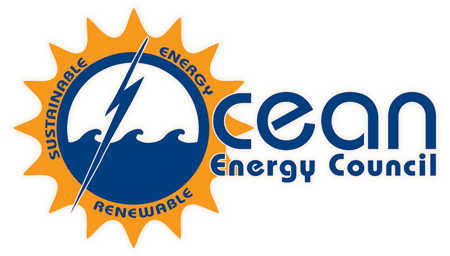Ocean thermal makes use of temperature gradients in a thermal (Rankine) cycle process. It requires the use large plants because of the low thermal efficiency, and hence, a large capital investment is needed for such plants. For example, at the Caribbean Sea, tropic waters meet and flow over artic waters with a temperature difference of 35°-40°F over a 1500-2000 ft vertical separation. Based on 35°F temperature difference, the Carnot cycle (best possible) efficiency is low, i.e., approximately 6%. The actual efficiency is 2-3% since the water must be pumped and there are thermal losses.
In 1929, a French engineer, George Claude, finally constructed a 22 kilowatt machine on the coast of Cuba. He took the warm surface water and put it into an evaporator. The pressure was lowered which caused the water to vaporize. It was forced through a turbine and it produced 22 kilowatts of electricity. Cold water was piped up from lower ocean depths to cool the vaporized water so the cycle could begin again. A problem with this was that the pipe to collect cold water at lower depths kept breaking off during storms. It was eventually abandoned because it was too much work to keep it working.
The new designs for OTEC are still mostly experimental. Only small-scale versions have been made. The largest so far is near Japan, and it can create 100 kilowatts of electricity. Another small-scale OTEC is off the coast of Hawaii, producing 50 kilowatts of electricity. If a successful OTEC is built, it is planned to produce 2 megawatts of electricity. However, a full scale OTEC would cost many millions of dollars, and it would be very difficult to build.
To compensate for its low thermal efficiency, OTEC has to move a lot of water. That means OTEC-generated electricity has a glut of work to do at the plant before any of it can be made available to the community power grid. Some 20 to 40 percent of the power, in fact, goes to pump the water through intake pipes in and around an OTEC system. While it took roughly 150 kilowatts of juice to run the Kailua-Kona test plant, larger commercial plants would use a lower percentage of the total energy produced.
That’s why, a century after the idea was first conceived, OTEC researchers are still striving to develop plants that consistently produce more energy than is needed to run the pumps, and that operate well enough in the corrosive marine climate to justify the development and construction.
OTEC plants must be located where a difference of about 40° Fahrenheit (F) occurs year round. Ocean depths must be available fairly close to shore-based facilities for economic operation. Floating plant ships could provide more flexibility. In the US, ocean thermal energy conversion is limited to tropical regions, such as Hawaii, and to a portion of the Atlantic coast.
Back to OTEC energy >>>
